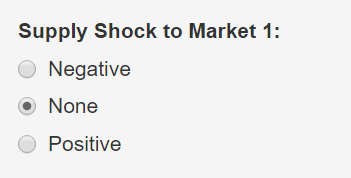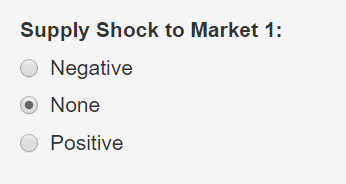So far, the impact of an exogenous shock has been considered for only one market. In many (if not most) cases, this is not a very good assumption. For instance, a shock to the pork market would be expected to have an impact on the beef and poultry markets because these products are substitutes for pork. Moreover, as shown in the Paarlberg, Lee, and Seitzinger (2002) and Paarlberg et al. (2008) studies on HMD mentioned above, something that affects livestock markets would likely affect markets for grain and other feedstuffs. Thus, an initial shock to the pork market will impact related product and input markets. You should account for feedback between these related markets as they adjust to a new equilibrium.
As additional markets are added into an equilibrium analysis framework, the problem becomes more complex. It may not be feasible to model all the related markets. In some cases, the best an analyst can do is assess a single market in isolation. This is called a partial equilibrium model. In a partial equilibrium model, you are ignoring feedback that may result from related markets.
General equilibrium models differ from partial equilibrium models in that they incorporate related markets or economic sectors into the analysis. In a general equilibrium model, feedback from other markets is considered to account for the fact that exogenous shocks occurring in other markets have implications for the market in question.
Classification of a model as a partial equilibrium or general equilibrium can vary a bit in the literature. Specifically, you will sometimes see a model described as partial equilibrium model even though multiple markets are included in the analysis. For example, Paarlberg, Lee, and Seitzinger (2002) and Paarlberg et al. (2008) classify their analyses as a partial equilibrium model, even though their models included markets for meat, dairy, livestock, and feedstuffs. This is because they restrict their focus to a tightly linked group of markets and do not examine the ramifications of an HMD outbreak on other sectors of the economy.
Normally, in a general equilibrium model, the equilibrium quantities and prices in all markets are endogenous. For instance, if you are modeling three related markets, there would be six endogenous variables: three equilibrium prices and three equilibrium quantities. Exogenous variables in a general equilibrium model again reflect any variable outside the system that shifts demand or supply in one or more markets. Note that when markets are related in consumption or production, the price in Market 2 will shift demand or supply in Market 1 and vice versa. However, prices are not exogenous because they are part of the equilibrium and are determined within the system of supply and demand equations that represent all markets included in the model. For this reason, the term “exogenous variable” is much better to use than the term “shift variable” within the context of an equilibrium model. The former implies that the value of the variable is determined outside the system. The latter just implies that the value of the variable causes a shift in one or more of the demand or supply schedules but does not indicate whether the value is determined internally or externally.
Feedback Between Markets in a General Equilibrium Model
To help you visualize feedback between markets, let us consider two markets that are related in demand but are unrelated in supply. This means the goods are either substitutes or complements to one another on the demand side of the market but are neither competing products or joint products on the supply side. Demonstration 4 depicts this situation for the case of substitutes in consumption. Use the demonstration to create a positive supply shock to Market 1. Now let us step through what happened:
- The positive supply shock to Market 1 causes a decrease in the equilibrium price and an increase in the equilibrium quantity as predicted in Table 1.
- Because Products 1 and 2 are substitutes in consumption, the lower price in Market 1 causes a leftward demand shift in Market 2, resulting in a lower price in Market 2 as well.
- The lower price in Market 2 feeds back into Market 1. Because the price in Market 2 is now lower and good 2 is a substitute for good 1, this causes the demand in Market 1 to shift inward and the price in Market 1 to falls further.
A couple of points are worth mentioning here. First, it should be clear that partial equilibrium models may over or understate the true impact of a shock. In the case just examined, feedback from Market 2 amplified the actual effect of the shock to Market 1. In other words, a partial equilibrium model that only included Market 1 would understate the price effect of positive supply shock. Second, in stepping through this example, adjustments to Markets 1 and 2 were presented as a sequential process, as steps 1-3. This was mainly to reinforce the intuition of feedback from Market 2 into Market 1. In reality, steps 1-3 occur simultaneously and the feedback is bidirectional as the markets in the system adjust to the new equilibria.
Take a moment to step through Demonstration \(\PageIndex{1}\) a second time. This time, create a negative supply shock to Market 1. Notice that prices in both markets increase and feedback from Market 2 to Market 1 again amplifies the price change in Market 1 over what would be observed in a partial equilibrium model.
Demonstration \(\PageIndex{1}\). Feedback between two markets that are substitutes in consumption but unrelated in supply



Demonstration (\PageIndex{2}\) provides an example for the case of complements in consumption. Use demonstration 5 to add a positive supply shock to Market 1. Again, you see that feedback from Market 2 amplifies the resulting change in equilibrium price in Market 1. In this case, however, it is for a different reason. The initial supply shock causes the price in Market 1 to fall. Because good 2 is a complement to good 1, this causes demand in Market 2 to increase and results in a price increase in Market 2, which feeds back into Market 1. Demand in Market 1 decreases as a result of the higher price in Market 2 which amplifies the the price reduction. You can repeat the process for a negative shock to Market 1 to see that the resulting price increase in Market 1 is similarly amplified by feedback from Market 2.
The top panels of Demonstrations (\PageIndex{1}\) and (\PageIndex{2}\) are very similar. In each case, feedback between the markets amplifies the price change to Market 1. The difference lies in the effects of the initial shock on Market 2. In the case of substitutes, the price change in Market 2 is of the same direction as the price change in Market 1. In the case of complements the price in Market 2 is of the opposite direction to the price change Market 1.
Finally, note that because these markets are unrelated in supply, there is no shift to the supply schedule in Market 2. In fact, this is the only schedule that does not shift as a result of the initial supply shock to Market 1.
Demonstration (\PageIndex{2}\). Feedback between two markets that are complements in consumption but unrelated in supply







